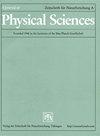Green creation of CoFe2O4 nanosorbent for superior toxic Cd ions elimination
IF 1.3
4区 物理与天体物理
Q4 CHEMISTRY, PHYSICAL
Zeitschrift Fur Naturforschung Section A-A Journal of Physical Sciences
Pub Date : 2023-11-09
DOI:10.1515/zna-2023-0180
引用次数: 0
Abstract
Abstract A mesoporous cobalt ferrite nanostructure was prepared by a green chemistry approach using Pimpinella anisum extract for Cd (II) ions elimination from an aqueous medium. The metal ions adsorption was explored under varying operating conditions, comprising of the pH, initial adsorbate concentration, and contact time. The synthesized sorbent was characterized by various techniques where the XRD data verified a ferrite structure of ≈25 nm crystallite size and the EDX elemental analysis affirmed the presence of the corresponding elements. The CoFe 2 O 4 established porosity characteristic of 10.8 m 2 g −1 BET-specific surface area and 0.023 cm 3 g −1 pore volume values. Batch mode experiments ascertained that the Cd (II) ions uptake was pH-dependent, with peak removal of 170 mg/g accomplished at pH = 5. The adsorption process of the metal ions onto the mesoporous nanomaterial surface fitted well with the Langmuir isotherm and pseudo-second-order kinetics models. The mechanistic aspects indicated the role of intra-particle and film diffusion in the adsorption process. The adsorbent could efficiently remove the pollutant up 74.3 % to four cycles of successful regeneration. This investigation endorsed that CoFe 2 O 4 might be potent candidate for heavy metals from aqueous systems.绿色制备CoFe2O4纳米吸附剂去除有毒Cd离子
摘要:采用绿色化学方法制备了介孔钴铁氧体纳米结构,并利用香草提取物去除水中的Cd (II)离子。考察了不同操作条件下(pH、初始吸附浓度和接触时间)对金属离子的吸附性能。通过各种技术对合成的吸附剂进行了表征,XRD数据证实其为铁氧体结构,晶粒尺寸约为25 nm, EDX元素分析证实了相应元素的存在。cofe2o4的孔隙度特征为10.8 m 2 g−1 bet比表面积和0.023 cm 3 g−1孔隙体积。批处理模式实验确定了Cd (II)离子的吸收与pH有关,在pH = 5时达到峰值170 mg/g。金属离子在介孔纳米材料表面的吸附过程符合Langmuir等温线和拟二级动力学模型。机理方面表明了颗粒内扩散和膜扩散在吸附过程中的作用。该吸附剂再生成功4次,对污染物的去除率高达74.3%。这项研究表明,CoFe 2o4可能是水中重金属的有力候选者。
本文章由计算机程序翻译,如有差异,请以英文原文为准。
求助全文
约1分钟内获得全文
求助全文
来源期刊
CiteScore
3.00
自引率
5.60%
发文量
81
审稿时长
3.3 months
期刊介绍:
A Journal of Physical Sciences: Zeitschrift für Naturforschung A (ZNA) is an international scientific journal which publishes original research papers from all areas of experimental and theoretical physics. Authors are encouraged to pay particular attention to a clear exposition of their respective subject, addressing a wide readership. In accordance with the name of our journal, which means “Journal for Natural Sciences”, manuscripts submitted to ZNA should have a tangible connection to actual physical phenomena. In particular, we welcome experiment-oriented contributions.

 求助内容:
求助内容: 应助结果提醒方式:
应助结果提醒方式:


